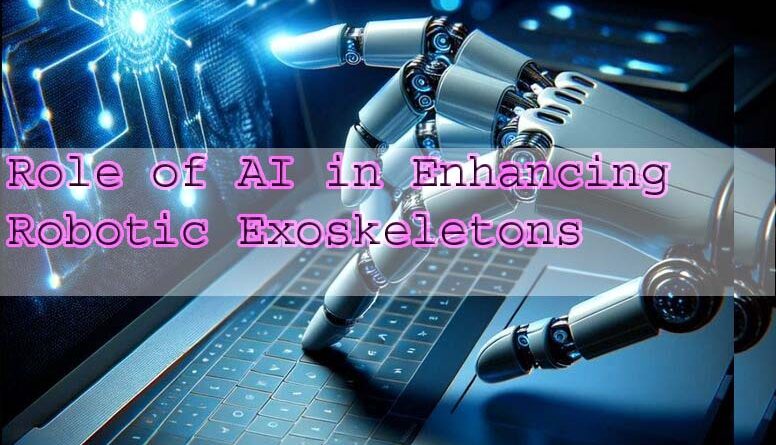AI Enhancements in Robotic Exoskeletons
Table of Contents
AI Crypto News
General ai law news highlights a groundbreaking evolution in assistive technology: the integration of artificial intelligence in robotic exoskeletons. These advanced systems are revolutionizing the way individuals with mobility challenges interact with their environments.
Integration of AI in Robotic Exoskeletons
General AI news emphasizes how AI algorithms are becoming crucial in understanding and predicting user movements, enhancing the adaptability of robotic exoskeletons. This integration allows for more intuitive control, leading to smoother and more natural movement for users.
AI-Driven Adaptability
Further insights from general AI news reveal that AI-driven adaptability is key to the success of these devices. By using machine learning, exoskeletons can learn and adjust to the unique gait and movement patterns of each user, providing personalized support and improving overall functionality.
Legal and Ethical Considerations
The intersection of AI law news and assistive technology brings to light several ethical and legal considerations. As AI continues to play a larger role in healthcare devices, ensuring compliance with regulations and protecting user data privacy are paramount.
Funding Through AI Crypto News
The latest AI crypto news suggests that blockchain and cryptocurrency are being leveraged to fund research and development in AI-enhanced exoskeletons. This innovative approach not only fosters financial support but also ensures transparency and security in transactions.
Aggregated Insights for Continuous Improvement
AI news aggregators play a crucial role in compiling data and insights from various sources, driving continuous improvement in AI technologies. These platforms help developers remain at the forefront of innovation by providing access to the latest trends and breakthroughs.
The Evolution of Assistive Technology
General AI news has been buzzing with the latest advancements in assistive technology, especially those involving AI enhancements in robotic exoskeletons. This groundbreaking innovation is set to revolutionize the way individuals with mobility impairments navigate their daily lives. Let’s delve into how AI is transforming these devices into more efficient and versatile tools.
Enhanced Mobility and Independence
AI-powered robotic exoskeletons are designed to provide enhanced mobility and independence for users. Incorporating sophisticated algorithms, these devices adapt in real-time to the user’s movements, offering a seamless and intuitive experience. These advancements are highlighted frequently in general AI news, showcasing their potential to change lives.
Personalized Assistance
Another significant development is the capability of these exoskeletons to deliver personalized assistance. By leveraging AI, these devices can learn from a user’s specific needs and preferences, offering tailored support. According to the latest ai news aggregator, this level of customization is unprecedented in assistive technology, making a profound impact on the user experience.
Integration with Other Technologies
Innovations in AI are also leading to the integration of robotic exoskeletons with other cutting-edge technologies. For instance, ai crypto news highlights how blockchain technology could enhance the security and privacy of data collected by these devices. This integration ensures that sensitive information is protected while also improving the functionality and reliability of the exoskeletons.
Regulatory and Ethical Considerations
With these advancements come important regulatory and ethical considerations. AI law news often addresses the evolving legal landscape surrounding these technologies. Ensuring that robotic exoskeletons are safe, accessible, and ethically designed is critical as they become more prevalent in general ai news.
In conclusion, the next frontier in assistive technology is being shaped by AI enhancements in robotic exoskeletons. As highlighted in general ai news, these innovations promise to provide unparalleled benefits in mobility, personalization, and integration with other technologies. As we continue to follow the latest ai news aggregator updates, it’s clear that the future of assistive technology is bright and full of potential.
Understanding Robotic Exoskeletons
The landscape of assistive technology is rapidly evolving, and “general ai news” often highlights the groundbreaking advancements in robotic exoskeletons. These wearable devices are designed to augment human mobility, providing support and strength to individuals with physical impairments. Initially, robotic exoskeletons were primarily mechanical, but the integration of AI has revolutionized their functionality and efficiency.
AI Integration in Exoskeletons
Modern robotic exoskeletons leverage AI to offer more personalized assistance. Through continuous learning algorithms, these devices adapt to the user’s specific needs, improving mobility and reducing the physical strain associated with movement. This evolution is also a frequent topic in “ai news aggregator” platforms, emphasizing the importance of tailored healthcare solutions.
Legal and Ethical Considerations
As robotic exoskeletons become more advanced, legal and ethical challenges emerge, as seen in “ai law news”. Issues such as data privacy, the extent of AI autonomy, and liability in case of malfunctions are crucial. Regulatory frameworks need to evolve to ensure that these technologies are used safely and ethically.
Cryptocurrency and Investment in Exoskeletons
Another interesting development covered in “ai crypto news” is the intersection of AI and blockchain technology in funding these innovations. Cryptocurrencies and blockchain ensure secure, transparent transactions, which can accelerate the development and deployment of robotic exoskeletons.
The Future of AI-Enhanced Exoskeletons
The future of robotic exoskeletons is promising, with AI playing a pivotal role. This transformative technology is not just about assisting individuals with disabilities but also enhancing human capabilities in general. As AI continues to evolve, so will the potential applications of exoskeletons, making it a hot topic in “general ai news”.
Role of AI in Enhancing Robotic Exoskeletons
Recent developments in general ai news have highlighted significant advancements in the field of robotic exoskeletons. These advanced systems are becoming increasingly sophisticated due to the integration of artificial intelligence (AI), leading to transformative changes in assistive technology.
Adaptive Learning and Personalization
One of the primary roles AI plays is in the adaptive learning and personalization of robotic exoskeletons. AI algorithms can analyze a user’s specific movements and preferences, learning from each interaction to provide a tailored experience. This level of customization is essential for individuals with unique physical needs, ensuring that the exoskeleton adapts to their requirements over time.
Real-Time Data Processing
Another groundbreaking feature highlighted in general ai news is real-time data processing. AI-enhanced exoskeletons can process vast amounts of sensory data in real time, allowing for immediate adjustments. This responsiveness is crucial for maintaining balance, improving mobility, and preventing falls.
Enhanced Safety and Efficiency
AI also plays a vital role in enhancing the safety and efficiency of robotic exoskeletons. By continuously monitoring the user’s movements and the environment, AI systems can predict potential hazards and adjust the exoskeleton’s functions accordingly. This proactive approach minimizes the risk of accidents and maximizes the efficiency of the device.
Integration with Other Technologies
General ai news often discusses the integration of AI with other emerging technologies. In the context of robotic exoskeletons, this means incorporating AI with IoT devices, blockchain for secure data transfer (as noted in ai crypto news), and even compliance with emerging regulations (as seen in ai law news). This multi-faceted approach ensures that exoskeletons are not only smarter but also more secure and compliant with global standards.
Future Prospects
The future of AI in robotic exoskeletons is promising, with ongoing research and development aimed at making these devices more accessible and effective. General ai news indicates that future enhancements will likely focus on further improving machine learning algorithms, enabling even more precise and intuitive user interactions. In conclusion, as general ai news continues to report, the role of AI in enhancing robotic exoskeletons is pivotal.
The integration of AI leads to smarter, more responsive, and personalized assistive devices, heralding a new era in assistive technology. By staying informed through ai news aggregators, we can watch as these innovations continue to evolve, bringing new possibilities and improved quality of life to those in need.
Real-World Applications and Success Stories
In the realm of general AI news, the integration of AI into robotic exoskeletons is revolutionizing assistive technology. These advanced devices are not just theoretical concepts but have found substantial real-world applications, significantly improving the quality of life for many individuals.
Transforming Mobility for the Disabled
AI-enhanced robotic exoskeletons are providing unprecedented mobility solutions for people with physical disabilities. These exoskeletons can adapt to the wearer’s movements, offering tailored support that traditional devices can’t match. Enhanced by continuous learning algorithms, these systems improve over time, making walking or even running a possibility for those who were previously confined to wheelchairs.
Supporting Rehabilitation and Therapy
In physical therapy, AI-driven exoskeletons play a crucial role. They not only assist therapists in providing more accurate and effective treatments but also collect valuable data on patients’ progress. This data-driven approach ensures customized rehabilitation plans, leading to faster and more complete recoveries. These advancements often feature prominently in AI law news due to the ethical considerations surrounding data privacy and patient consent.
Boosting Workforce Capabilities
In industrial settings, AI-powered exoskeletons are enhancing human capabilities, allowing workers to lift heavier loads and reduce the risk of injuries. This technology is making a significant impact on workplace safety and productivity, showcasing the practical benefits of AI in everyday tasks. For businesses, this represents a convergence of AI and industry that is frequently highlighted in AI news aggregators.
Enhancing Military and Emergency Services
Military and emergency services are also beneficiaries of AI-enhanced exoskeletons. These devices provide soldiers and first responders with increased strength and endurance, allowing them to perform their duties more effectively and safely. There are ongoing discussions in AI law news about regulations and ethical use in these critical sectors.
Real-Life Success Stories
Many success stories underscore the transformative potential of AI in exoskeleton technology. For instance, individuals with spinal cord injuries have regained the ability to walk through the use of these advanced devices. Similarly, stroke survivors have experienced significant improvements in their motor functions, highlighting the life-changing impact of this technology. The future of assistive tech, as reported in general AI news, lies in the continuous evolution of AI enhancements in robotic exoskeletons. From helping the disabled to augmenting human capabilities in various fields, these advancements represent a significant leap forward in how AI can positively influence our lives.
Challenges and Limitations
General AI news often highlights the rapid advancements and potential of AI-driven technologies, but it is equally important to understand the challenges and limitations these innovations face. When it comes to AI-enhanced robotic exoskeletons, several key issues must be addressed to move forward effectively.
Cost and Accessibility
The high cost of developing and producing sophisticated AI-driven exoskeletons remains a significant barrier to widespread adoption. Many healthcare facilities and individuals cannot afford these advanced devices, limiting their accessibility to those who could benefit the most. This is a common topic in AI news aggregators highlighting the need for more affordable solutions.
Regulatory and Legal Challenges
AI law news frequently discusses the complexities surrounding the regulation of new technologies. For robotic exoskeletons, establishing clear legal frameworks and safety standards is crucial to ensure their safe and effective use. The regulatory landscape must evolve to accommodate the rapid pace of AI advancements while protecting users’ rights and safety.
Technical Limitations
Despite the promise shown in general AI news, current AI-enhanced exoskeletons still face technical hurdles. These include issues with battery life, sensor accuracy, and the seamless integration of AI algorithms with the mechanical components of the exoskeleton. These technical challenges need continuous research and development to overcome.
Ethical Considerations
AI crypto news often touches on the ethical implications of AI technologies. In the context of robotic exoskeletons, ethical considerations include ensuring that AI systems respect user autonomy and privacy, and do not exacerbate existing inequalities. There is also a need for transparent AI systems that users can trust and rely on.
User Training and Adaptation
Another critical issue highlighted in AI news aggregators is the need for comprehensive user training programs. Effective use of AI-enhanced exoskeletons requires users to undergo training to adapt to the new technology. This training needs to be accessible and tailored to individual needs to be effective.
Interoperability and Integration
Ensuring that AI-enhanced exoskeletons can integrate smoothly with other assistive devices and healthcare systems is another challenge. This interoperability is essential for creating a cohesive and efficient support system for users, as often noted in general AI news. In conclusion, while general AI news is filled with exciting advancements in AI-enhanced robotic exoskeletons, attention must also be given to the significant challenges and limitations that need to be addressed. By focusing on cost reduction, regulatory frameworks, technical improvements, and ethical considerations, the full potential of these innovative devices can be realized, ultimately enhancing the lives of those who rely on them.
The Future of AI in Assistive Tech
In recent general AI news, the integration of AI in robotic exoskeletons marks a significant leap forward in assistive technology. These advanced devices, equipped with AI enhancements, are designed to help individuals with mobility impairments regain movement and independence. By analyzing real-time data, AI-driven exoskeletons can adapt to the user’s movements, providing a personalized and responsive support system.
AI-Powered Adaptability
One of the most exciting developments in AI-enhanced exoskeletons is their ability to learn and adapt. Through machine learning algorithms, these devices can understand the unique gait and movement patterns of their users. This adaptability ensures that the exoskeleton provides the necessary support and resistance, making movements more natural and less strenuous.
Enhanced Safety and Reliability
AI’s role in ensuring the safety and reliability of robotic exoskeletons cannot be overstated. By continuously monitoring the user’s movements and the exoskeleton’s performance, AI can detect any anomalies or potential issues. This proactive monitoring system reduces the risk of malfunctions and enhances the user’s confidence in the device, as highlighted in several AI law news updates.
Integration with Other Technologies
Another frontier in AI-enhanced exoskeletons is their integration with other cutting-edge technologies. For instance, AI news aggregators have reported on the compatibility of exoskeletons with virtual reality (VR) systems. This combination can provide immersive rehabilitation experiences, offering users a more engaging and effective way to regain mobility.
Future Prospects
Looking ahead, the relationship between AI and robotic exoskeletons will only grow stronger. Advances in AI crypto news suggest that secure and decentralized systems can be employed to protect user data. As these technologies evolve, we can expect even more sophisticated and user-friendly exoskeletons that will redefine the standards of assistive tech.
Regulatory and Legal Considerations
General AI news highlights the rapid advancements in AI-driven robotic exoskeletons, presenting unique regulatory and legal challenges. As these technologies evolve, compliance with existing medical device regulations and adapting to new AI-specific guidelines becomes crucial.
Compliance with Medical Device Regulations
Adhering to medical device regulations is essential for the deployment of AI-enhanced robotic exoskeletons. These devices must meet safety and efficacy standards set by regulatory bodies like the FDA and EMA. This involves rigorous testing and clinical trials to ensure the exoskeletons provide the intended therapeutic benefits without adverse effects.
Adapting to AI-Specific Guidelines
As AI continues to integrate into medical devices, new AI-specific regulatory guidelines are emerging. Staying updated with AI law news is vital for manufacturers, as these guidelines often address data privacy, algorithm transparency, and ethical considerations. Ensuring that AI algorithms are explainable and free from bias is necessary to maintain public trust and comply with legislation.
Intellectual Property and Patent Issues
The intersection of AI crypto news and robotic exoskeletons brings forth complex intellectual property (IP) challenges. Protecting proprietary AI algorithms and hardware innovations requires robust patent strategies. Companies must navigate these complexities to safeguard their competitive edge while fostering innovation within legal frameworks.
Global Regulatory Landscape
The regulatory environment for AI in robotic exoskeletons varies significantly across different regions. An AI news aggregator can help stakeholders stay informed about global regulatory developments. Understanding the nuances of international regulations is key to successful market entry and compliance. In conclusion, general ai law news underscores the evolving regulatory and legal landscape for AI-enhanced robotic exoskeletons. Navigating these considerations requires a proactive approach to compliance, intellectual property protection, and staying informed through reliable AI news aggregators. As the next frontier in assistive technology, these advancements hold immense potential, provided they align with stringent regulatory standards.
ai law news
In recent developments in general ai law news, the intersection of artificial intelligence and assistive technology is transforming lives. AI enhancements in robotic exoskeletons are emerging as a groundbreaking innovation, offering unprecedented mobility and independence to individuals with physical disabilities. These advancements highlight the potential of AI to revolutionize the healthcare and assistive tech industries.
AI-Powered Improvements in Robotic Exoskeletons
AI law news often spotlights the ethical and regulatory frameworks surrounding AI technologies. This is particularly relevant as AI-enhanced robotic exoskeletons bring forth considerations in data privacy, user safety, and equitable access. With ai law news ability to process complex biomechanical data in real-time, these exoskeletons can adapt swiftly to the user’s movements, providing tailored support and facilitating smoother, more natural motion.
Integration of AI Crypto News
The influence of AI extends into financial domains such as AI crypto news. The integration of blockchain technology within AI-enhanced assistive devices offers secure and transparent data handling. This can lead to advancements in user data security, ensuring that sensitive health information is protected while still allowing for effective AI functionality.
The Role of ai law news Aggregators
AI news aggregator platforms play a crucial role in disseminating information regarding these technological advancements ai law news. By curating the latest updates and research, these aggregators help stakeholders stay informed about innovations and regulatory changes in the field. This collective knowledge base supports informed decision-making and fosters ongoing improvements in the technology.




